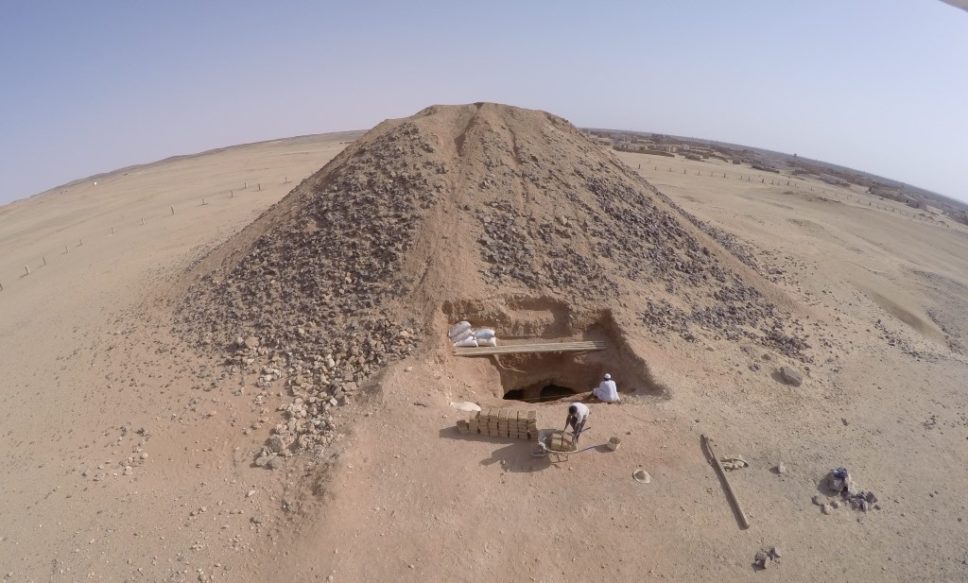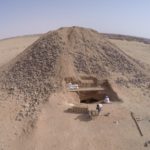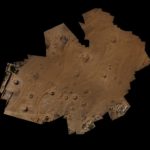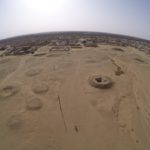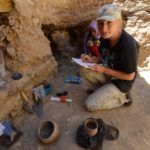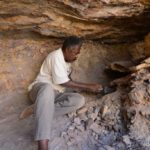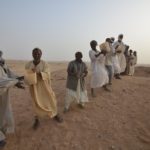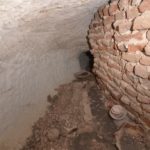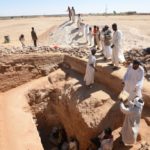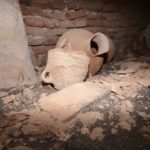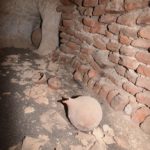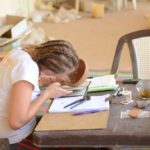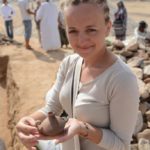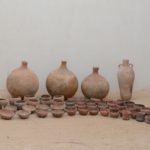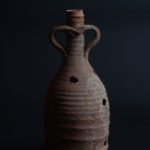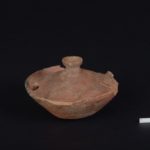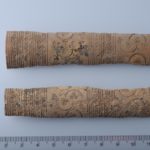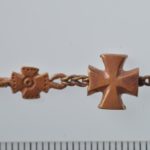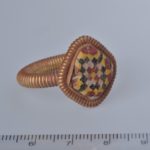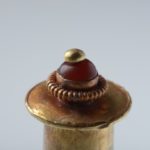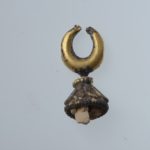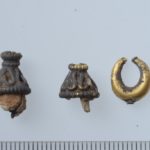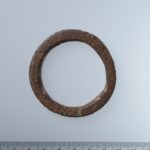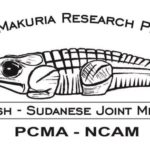El-Zuma
-
Project name:
Early Makuria Research Project
(M to M)Project logo:
-
Type of site:
Cemetery – tumuli graves
Location:
Sudan
Northern province, between the 3rd and 4th Cataract, on the right bank of the Nile
Area of the ancient kingdom of MakuriaDating:
– early Makurian period, 2nd phase (mid-4th–mid-6th century AD)
Most interesting finds:
– grave architecture: eight large tumuli of unique construction, provided with tunnels leading from the outside to the burial chamber
– collection of pottery vessels
– collection of jewelry typical of the period
– bone objects
– the burial chambers of the majority of the tumuli have been plundered, which testifies to the wealth and high status of the people buried there
History of research:
Dates of PCMA mission’s work:
2005, 2007, 2009, 2011–2017
Type of research:
Excavations
Directors:
Mahmoud El-Tayeb, Polish Centre of Mediterranean Archaeology, University of Warsaw
Co-operating institutions:
Polish Centre of Mediterranean Archaeology, University of Warsaw
National Corporation for Antiquities and Museums
Qatar-Sudan Archaeological Project
Additional information:
Earlier archaeological research on site included a visit by Karl Richard Lepsius in the mid-19th century and a prospection in 1998 as part of a survey conducted by Bogdan Żurawski.
In 2014, 2015 and 2017, the research was funded from a grant of the Nubian Archaeological Development Organization Qatar-Sudan Archaeological Project (QSAP).
In the framework of the El-Zuma project, Urszula Iwaszczuk conducts research funded by a National Science Centre grant ‘Opportunities for the El-Zuma/El-Detti and Tanqasi microregions economy research on the basis of animal bone remains from the funerary context’ (Preludium 7, 2014/13/N/HS3/04620).
Apart from archaeological excavations, the mission’s work includes studies on anthropology (Robert Mahler), archaeozoology (Urszula Iwaszczuk), pottery (Ewa Czyżewska-Zalewska) and metal objects (Joanna Then-Obłuska – ornaments, Łukasz Zieliński). Every year during the excavation season, a training program for students of archaeology from the Dongola University (Department of Archaeology in Karima), the Neelain University in Khartoum and the University in Khartoum North is carried out, as well as a training program for the NCAM staff.
Description of the site and research:
The cemetery at El-Zuma has been inscribed onto the UNESCO World Heritage List on account of the unique tumuli located there (as part of the Gebel Barkal and the Sites of the Napatan Region preservation program). There are approximately 30 tumuli at the site, including a few very large ones which measure up to 50 m in diameter and up to 10 m in height. The burial chambers of the majority of the tumuli have been plundered, which testifies to the wealth and high status of the people buried there.
During the mission’s work, 29 tumuli have been excavated and divided into three categories:
Type I – the eight largest tumuli. The mounds are conical, built of sand mixed with small stones and covered with flat stones of different sizes. They measure from 25 to 50 m in diameter and are from 3.5 m to 11 m high. The burial shafts and chambers were cut in the soft sandstone bedrock. In the tumuli of this type, the tunnels are located on the southern side and lead northwards to the main burial chambers. They have not been made by robbers and belong to the original construction of the graves. These tumuli have one main burial chamber and up to four additional chambers. The main shaft is U-shaped with the pier (pillar) always located on the eastern side.
Type II – approximately 10 tumuli. The mounds have a flattened top. They measure from 20 to 30 m in diameter (at the base) and are 2–3 m high. This type does not feature a tunnel, and the main burial shaft is U-shaped with the pier (pillar) located on the eastern side. The main burial chamber lies by the south wall, and there are 2 or 3 additional chambers. In the tumuli of Type I and II, the burial chambers were originally blocked with unworked stones, mud bricks or baked bricks which probably came from an earlier, official building dating to the Meroitic period.
Type III – the smallest structures. They measure approximately 10–15 m in diameter (at the base) and do not exceed 0.7 m in height. There is a stone ring around the base of the mound. The rectangular burial shaft is oriented N–S; it measures approximately 2–3 m by 1.5–2 m and is 2 to 3 m deep. Sometimes it features an additional step in the corner or a bench on the eastern side. In the tumuli of Type III, there is only one burial chamber, situated on the western side. Two chambers were found only in one grave. The location of the chamber in the west is a reference to the Meroitic architectural tradition.
The differences between the three types of graves point to the different social standing of the people buried in them rather than to a different chronology. The eight largest tumuli probably belonged to the representatives of the elite. The most spectacular are Tumuli 6 and 7 where the tunnels are divided by a row of pillars. These two graves are located in the highest part of the site. In Tumulus 6, a skeleton lying face upwards was found, which is an exception among the burials at El-Zuma and may suggest that the deceased was of very high social status. Among the finds, ornaments with crosses discovered in two tumuli are especially interesting.
Information about the research:
Events connected with the project:
2021-05 Monograph on excavations in El-Zuma (Sudan) published by Brill
Mahmoud El-Tayeb, & Czyżewska-Zalewska, E. (Eds.). (2020). Early Makuria Research Project. El-Zuma cemetery: Vol. 1. Brill. https://doi.org/10.1163/9789004433755
Czyżewska-Zalewska, E., & Cedro, A. (2020). Early Makuria Research Project. El-Zuma cemetery: Vol. 2. The pottery. Brill. https://doi.org/10.1163/9789004433755
Then-Obłuska, J., Zieliński, Ł., & Czyżewska-Zalewska, E. (2020). Early Makuria Research Project. El-Zuma cemetery: Vol. 3. Small finds. Brill. https://doi.org/10.1163/9789004433755
Czyżewska-Zalewska, E., Kowarska, Z. (2020). Modern and Ancient Pottery Traditions in the el-Zuma and Karima Region in Sudan: An Introduction to Comparative Studies (Pots Project). International Journal of Historical Archaeology. https://doi.org/10.1007/s10761-019-00524-9
Iwaszczuk U, Niderla-Bielińska J, Ścieżyńska A (2019). Kings and peasants from El-Zuma/El-Detti microregion in the Early Makurian period. Economic aspects of animal bones from funerary contexts. PLoS ONE 14(2): 0212423. https://doi.org/10.1371/journal.pone.0212423
Czyżewska-Zalewska, E. (2017). Early Makuria Research Project. Remarks on pottery production in the light of new material at El-Zuma. Polish Archaeology in the Mediterranean 26/1, 355–366
El-Tayeb, M. (2017). Early Makuria Research Project. Excavations at el-Zuma, 2017. Preliminary report. Polish Archaeology in the Mediterranean 26, 339–354
Czyżewska-Zalewska, E. (2016). Pottery from El-Zuma in Sudan: remarks on production, technology and usage. Polish Archaeology in the Mediterranean 25, 725–740
El-Tayeb, M., Skowrońska, E., Czyżewska, E. (2016). Early Makuria Research Project. The Results of Three Seasons of Excavation at El-Zuma Cemetery, 2013, 2014 and 2015. Sudan and Nubia 20, 110–126
Then-Obłuska, J. (2016). Trade and faith in Nubian early Makuria (AD 450 550): macroscopic examination of personal adornments from el-Zuma in Nubia. Polish Archaeology in the Mediterranean 25, 741–760
Iwaszczuk, U. (2015). Animal remains from the Early Makurian cemetery in El-Zuma (season 2013). Polish Archaeology in the Mediterranean 24/1, 425–430
El-Tayeb, M., Juszczyk-Futkowska, K. and Czyżewska, E. (2014). El-Zuma 2011: the fourth season of excavations on the site. Preliminary report. Polish Archaeology in the Mediterranean 23/1, 357–374
Zieliński, Ł. (2014). Metal objects from el-Zuma cemetery, 2011. Polish Archaeology in the Mediterranean 23/1, 375–390
El-Tayeb, M. (2012). Funerary traditions in Nubian Early Makuria (=GAMAR Monograph Series 1). Gdańsk: Muzeum Archeologiczne w Gdańsku
Klimaszewska-Drabot, E., Czyżewska, E. (2012). The pottery from four tumuli graves in El-Zuma (2009). Polish Archaeology in the Mediterranean 21, 361–376
El-Tayeb, M. and Czyżewska, E. (2011). Early Makuria Research Project. Excavations at El-Zuma. The third season, Jan.–Feb. 2009. Sudan & Nubia 15, 108–118
Juszczyk, K. (2011). Report on burial architecture of tumuli T.11 and T.13. Sudan & Nubia 15, 119–123
El-Tayeb, M. (2010). Early Makuria Research Project. Excavations at El-Zuma, in: Godlewski, W. and Łajtar, A., Between the Cataract. Proceedings of the 11th Conference for Nubian Studies. Warsaw University, 27 August–2 September 2006, Warsaw Part. II, (Polish Archaeology in the Mediterranean Supplement Series 2.2/1-2), 205–217
El-Tayeb, M. (2010). Early Makuria Research Project. El-Zuma excavations. Preliminary report on the second season, 2007. Polish Archaeology in the Mediterranean 19, 467–479
Klimaszewska-Drabot, E. (2010), Pottery from the cemetery in El-Zuma (2007 season). Polish Archaeology in the Mediterranean 19, 480–487
Osypińska, M. (2010). Animal bone remains from the cemetery in El-Zuma (2007 season). Polish Archaeology in the Mediterranean 19, 488–493
El-Tayeb, M. (2007). Early Makuria Research Project. Test Excavation in El-Zuma Cemetery, in: B. Gratien (ed.), Mélanges offerts à Francis Geus (=CRIPEL 26), Lile, 71–86
El-Tayeb, M. (2005). Early Makuria Research Project excavations at El-Zuma, Preliminary report. Polish Archaeology in the Mediterranean 16, 389–403 with Appendix: Obłuski, A., Remarks on a survey of the tumuli field at El-Zuma, 400–403
Osypińska, M. (2005). Animal bones from the Excavations at. El-Zuma. Polish Archaeology in the Mediterranean 16, 404-408
Wybrana bibliografia stanowiska:
Lepsius, K. R. (1897–1901). Denkmäler aus Aegypten und Aethiopien, Text (ed. E. Naville), 5 vols, Leipzig
Lepsius, K. R. (1849–1859). Denkmäler aus Aegypten und Aethiopien,, 6 vols, Berlin
Gallery:
-
1. Tumulus 7 (type I), securing the tunnel entrance after the exploration of the grave / Tumulus 7 (typ I), prace zabezpieczające wejście do tunelu (zabezpieczenie po eksploracji grobu) (Fot. T. Wojtczak)
-
2. Kite photograph of the El-Zuma site / Zdjęcie latawcowe stanowiska w El-Zuma (Fot. A. Kamrowski, S. Lenarczyk)
-
3. View of the site / Widok stanowiska (Fot. T. Wojtczak)
-
4. Tumulus 26 (type II), documentation work in the shaft near the main chamber / Tumulus 26 (typ II), prace dokumentacyjne w szybie przy komorze głównej (Fot. A. Kamrowski)
-
5. Tumulus 26 (type II), exploration of the main burial chamber / Tumulus 26 (typ II), eksploracja głównej komory grobowej (Fot. A. Kamrowski)
-
6. Workers during the excavations / Robotnicy podczas prac wykopaliskowych (Fot. A. Kamrowski)
-
7. View of tumulus 6 (type I) / Widok na tumulus 6, typu I (Fot. A. Kamrowski)
-
8. Tumulus 6, view of the main burial chamber before exploration / Tumulus 6, widok głównej komory grobowej, jeszcze nie eksplorowanej (fot. A. Kamrowski)
-
9. Tumulus 6, work in the external shaft leading to the tunnel entrance / Tumulus 6, prace przy zewnętrznym szybie prowadzącym do tunelu tumulusa (Fot. A. Kamrowski)
-
10. Tumulus 7 (type I), view of the main chamber with grave goods before exploration / Tumulus 7 (typ I), widok komory głównej z darami przed eksploracją (Fot. A. Kamrowski)
-
11. Tumulus 7 (type I), view of the main chamber with grave goods before exploration / Tumulus 7 (typ I), widok komory głównej z darami przed eksploracją (Fot. Kamrowski)
-
12. Documentation work at the base / Prace dokumentacyjne w bazie (Fot. A. Kamrowski)
-
13. Lamp (Z6/21) found in the tunnel of tumulus 6 / Lampka (Z6/21) odkryta w tunelu tumulusa 6 (Fot. A. Kamrowski)
-
14. Tumulus 26, pottery from all the burial chambers / Tumulus 26, ceramika odkryta we wszystkich komorach grobowych (Fot. A. Kamrowski)
-
15. Imported amphora found in the tunnel of tumulus 4 / Importowana amfora znaleziona w tunelu w tumulusie 4 (Fot. A. Kamrowski)
-
16. Lamp (Z4/200) found in the tunnel of tumulus 4 / Lampka (Z4/200) znaleziona w tunelu tumulusa 4 (Fot. A. Kamrowski)
-
17. Z4/54 bone containers found in the tunnel of tumulus 4 / Z4/54 pojemniki z kości odkryte w tunelu tumulusa 4 (Fot. A. Kamrowski)
-
18. Z4/98 small chain with a cross found in the tunnel of tumulus 4 / Z4/98 łańcuszek z z krzyżykiem znaleziony w tunelu tumulusa 4 (Fot. A. Kamrowski)
-
19. Z4/97 ring found in the tunnel of tumulus 4 / Z4/97 pierścień znaleziony w tunelu tumulusa 4 (Fot. A. Kamrowski)
-
20. Z4/213.1-2 decorated metal elements found in the tunnel of tumulus 4 / Z4/213.1-2 dekorowane elementy metalowe odkryte w tunelu tumulusa 4 (Fot. A. Kamrowski)
-
21. Z4/96 handle of a lid found in the tunnel of tumulus 4 / Z4/96 uchwyt pokrywki z tunelu tumulusa 4 (Fot. A. Kamrowski)
-
22. Z1/32 earrings found in tumulus 1 / Z1/32 kolczyki odkryte w tumulusie 1 (Fot. A. Kamrowski)
-
23. Z1/32 earrings found in tumulus 1 / Z1/32 kolczyki odkryte w tumulusie 1 (Fot. A. Kamrowski)
-
24. Z4/86 presumably a handle of a metal vessel, found in tumulus 4 / Z4/86 prawdopodobnie uchwyt metalowego naczynia, znaleziony w tumulusie 4 (Fot. A. Kamrowski)
-
Early Makuria Research Project – Logo

